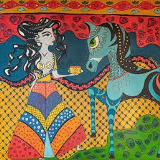Lore of the Unicorn (3): Gall and Ankle-bones · 9:16pm May 24th
Setting aside the matter of bronies and anti-bronies, the book continues with a brief summary of the life of Cstesias, an ancient Greek physician who will play an important role in the birth of the unicorn in the European imagination. For, as it turns out, the mystery of unicorns “[leaves] a wide field for speculation and [surrounds] even the facts of which we are certain with bands of twilight…”
Indeed, with regard to that field of study, Cstesias cannot be expected to keep pace with the advances that have been made in the last fifteen years, no more than we might expect Aristotle to agree with our modern notions of thermodynamic principles. All the same, this does not mean that Aristotle was wrong, given the body of techniques and cultural synthesis that was available to him.
So with Cstesias.
The most frequently cited topic in The Lore of the Unicorn, after the unicorn itself, is the alicorn (about which there will be more to say later):

After this, however, comes charging the rhinoceros:

Now, in the post-information age, we have obtained a certain measure of clarity—if not in moral issues, then at least in the notion that a rhinoceros is not the same thing as a unicorn. But, turning to that peculiar period of mystic effulgence and rational innovation which we call Greece of the Golden Age, this was not always the case; and Cstesias, whom Mr. Shepard paints for us as a would-be Herodotus, is a figure of his time in describing the first recorded unicorn:
“There are in India certain wild asses as large as horses, and larger. Their bodies are white, their heads dark red, and their eyes dark blue. They have a horn on the forehead which is about a foot and a half in length. The dust filed from this horn is administered in a potion as a protection against deadly drugs. The base of this horn, for some two hands’-breadth above the brow, is pure white; the upper part is sharp and of a vivid crimson; and the remainder, the middle portion, is black. […] Other asses, both the tame and the wild, and in fact all animals with solid hooves, are without the ankle bone and have no gall in the liver, but these have both the ankle-bone and the gall. This ankle bone, the most beautiful I have ever seen, is like that of an ox in general appearance and size, but it is as heavy as lead and its color is that of cinnabar through and through. The animal is exceedingly swift and powerful, so that no creature, neither the horse nor any other, can overtake it.”

A scientifically rendered image of Cstesia’s unicorn, courtesy of the Muséum d’histoire naturelle, Geneva.



I doubt he wanted to fuck it though, but you'd never known with those ancient theoretics who like augurs were casting their thoughts and observations far into the future, only for us to fish them out later from the muddy waters of history.
'Cstesias' is a kickass name by the way
5782808
...Your name wouldn't happen to be Cstesias, would it?
5782914
I might legally change it now!